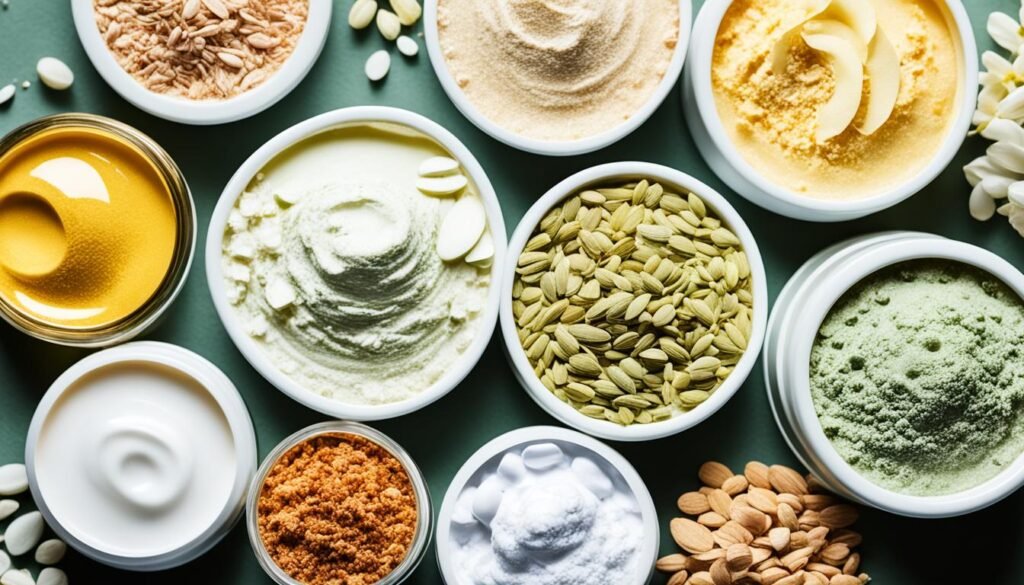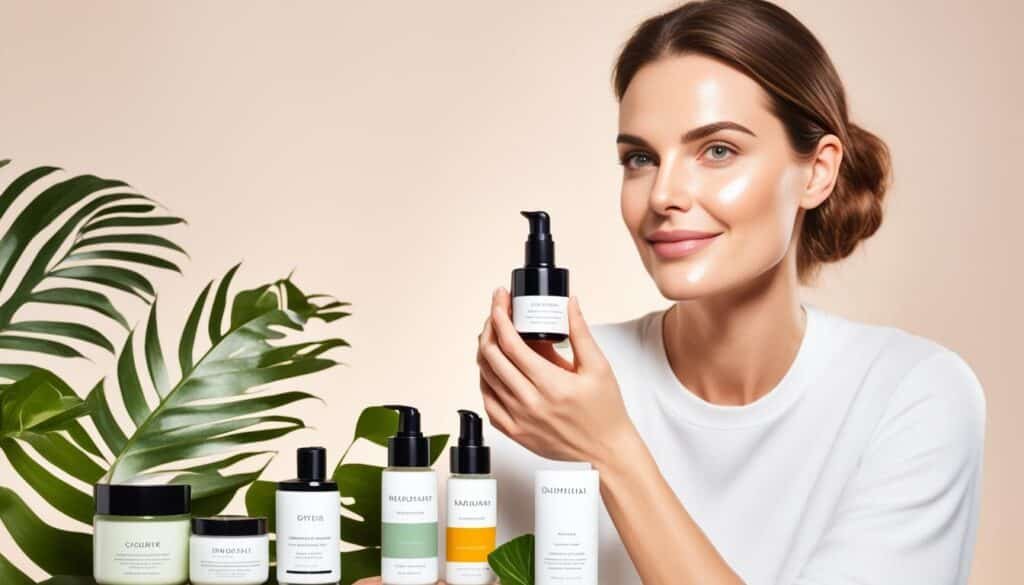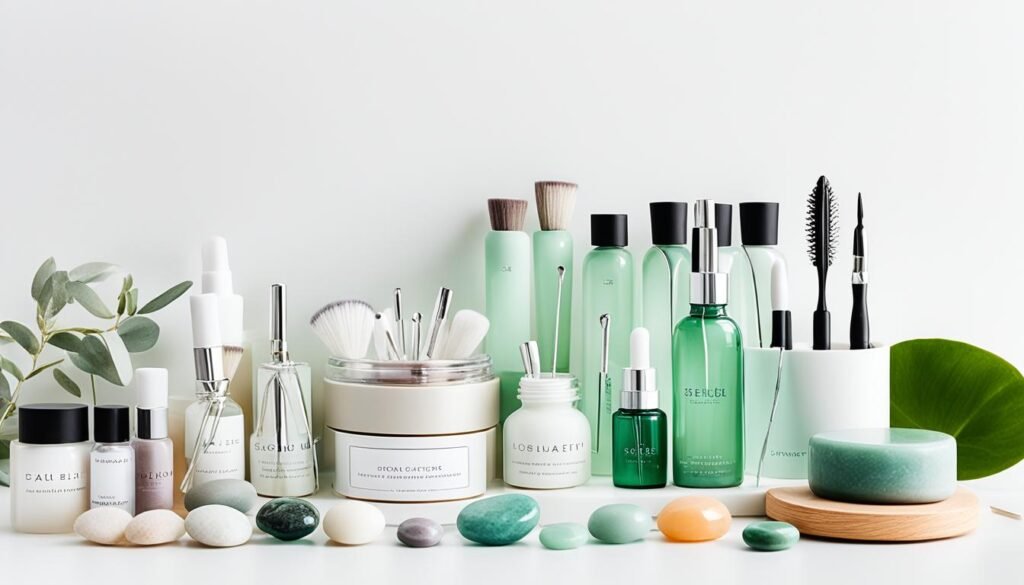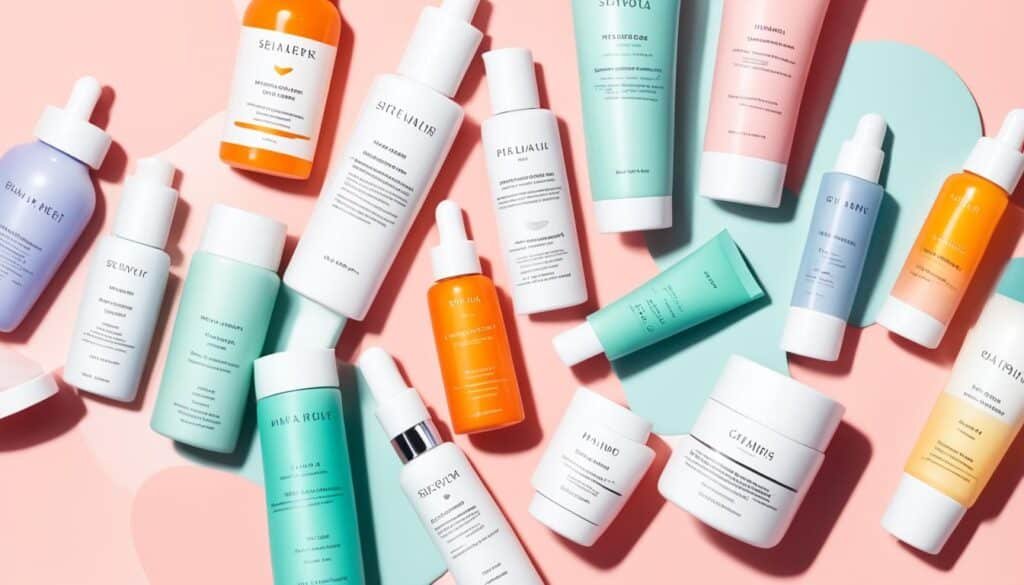Mastering Skincare When it comes to achieving radiant and healthy skin, a one-size-fits-all approach simply won’t cut it. Each individual has unique skincare needs that require tailored attention and personalized products. Mastering skincare means understanding the intricacies of your own skin and adapting skincare products to cater to its specific requirements.
A well-crafted skincare routine is the foundation of any effective skincare regimen. By incorporating esthetician skincare products into your daily routine, you can provide your skin with the nourishment and care it deserves. From cleansers to serums, moisturizers to specialized treatments, esthetician skincare products offer a wide range of options to address various skin concerns and types.
Throughout this article, we will explore the power of skincare ingredients, the importance of personalizing skincare for clients, essential tools for estheticians, and effective skincare application techniques. We will dive into the world of esthetician skincare, unveiling the secrets to achieving optimal skin health. Are you ready to embark on your personalized skincare journey?
Key Takeaways:
- Mastering skincare involves adapting products to your skin’s unique needs.
- A personalized skincare routine is essential for achieving radiant and healthy skin.
- Esthetician skincare products offer tailored solutions for different skin concerns and types.
- Skincare ingredients play a crucial role in the efficacy of skincare products.
- Personalizing treatments based on client needs is vital for long-term results.
Understanding Skincare Products for Estheticians
Skincare products play a crucial role in a comprehensive skincare routine for estheticians and their clients.
Estheticians have a wide range of products at their disposal, each serving a specific purpose in achieving optimal skin health and addressing various skin concerns.
The Essential Skincare Products
Let’s explore some of the key skincare products that estheticians utilize:
- Cleansers: Cleansers are the first step in any skincare routine, effectively removing dirt, oil, and impurities from the skin.
- Toners: Toners help balance the skin’s pH level, refine pores, and prepare the skin for better product absorption.
- Serums: Serums are lightweight formulations that deliver concentrated active ingredients to target specific skin concerns like hydration, brightening, and anti-aging.
- Moisturizers: Moisturizers provide hydration and help maintain the skin’s moisture barrier, keeping it supple and protected.
- Specialized Treatments: Specialized treatments like masks, exfoliators, and spot treatments address specific skin concerns such as acne, hyperpigmentation, and sensitivity.
By understanding the benefits and functions of each product, estheticians can recommend the most suitable options based on their clients’ skin type and concerns.
It’s important to consider each individual’s unique needs to create a tailored skincare routine that delivers optimal results.
Customizing for Different Skin Types
One of the key aspects of using skincare products as an esthetician is considering the different skin types and tailoring the products accordingly.
Different skin types have specific needs and using the appropriate products can address those needs effectively.
Let’s take a look at a table that outlines the key skincare products and their potential benefits for different skin types:
| Skincare Product | Normal Skin | Dry Skin | Oily Skin | Combination Skin | Sensitive Skin |
|---|---|---|---|---|---|
| Cleansers | Gently cleanses without stripping moisture | Hydrates while removing impurities | Controls excess oil and unclogs pores | Balances oil production and removes impurities | Calms and soothes without irritation |
| Toners | Refreshes and balances pH | Hydrates and nourishes | Controls oil and minimizes pore appearance | Helps balance oil production | Soothes and calms inflammation |
| Serums | Boosts hydration and radiance | Provides deep moisture and nourishment | Minimizes pore appearance and controls sebum | Targets specific concerns in different areas | Gentle and non-irritating with soothing ingredients |
| Moisturizers | Maintains balanced hydration | Intensely moisturizes and locks in moisture | Lightweight and oil-free | Hydrates without clogging pores | Provides gentle and soothing hydration |
| Specialized Treatments | Enhances radiance and overall skin health | Hydrates and nourishes dry, flaky skin | Controls oil production and prevents breakouts | Targets specific concerns in different areas of the face | Calming and soothing for sensitive skin |
By understanding the benefits of each product and customizing them according to different skin types, estheticians can provide targeted solutions and achieve the best results for their clients.
Now that we have a better understanding of the various skincare products available and how they can be tailored to different skin types and concerns, let’s explore the power of ingredients in skincare in the next section.
The Power of Ingredients in Skincare
When it comes to skincare, the right ingredients can make all the difference. Skincare ingredients, such as retinoids, hyaluronic acid, vitamin C, and alpha hydroxy acids, have been scientifically proven to deliver remarkable benefits for various skin concerns.
Retinoids are a form of vitamin A that promote cell turnover and collagen production, helping to reduce the appearance of fine lines and wrinkles. They also work wonders for acne-prone skin by unclogging pores and preventing breakouts.
Hyaluronic acid is a hydrating powerhouse that attracts and retains moisture, keeping the skin plump and supple. It also helps to smooth out rough texture and diminish the appearance of fine lines.
“Skincare is a journey that involves understanding the power of the right ingredients and their ability to transform the skin.”
Vitamin C is a potent antioxidant that brightens the complexion and evens out skin tone. It also helps to protect the skin from damaging free radicals, resulting in a more youthful and radiant appearance.
Alpha hydroxy acids (AHAs) are gentle exfoliators that remove dead skin cells and improve skin texture. They are particularly beneficial for dull and uneven skin, helping to reveal a smoother and more youthful complexion.
As an esthetician, it is essential to guide your clients towards skincare products that contain these powerful ingredients. Understanding the benefits and functions of each ingredient allows you to recommend the most effective products for their specific needs. By harnessing the power of skincare ingredients, you can help your clients achieve their skincare goals and enhance their overall skin health.

Key Benefits of Skincare Ingredients:
- Promote cell turnover and collagen production
- Hydrate and plump the skin
- Brighten the complexion and even out skin tone
- Smooth out rough texture and diminish fine lines
- Exfoliate and improve skin texture
Unlock the power of skincare ingredients and revolutionize your clients’ skincare routines. By incorporating these game-changing ingredients into their daily regimen, they can achieve healthier, more radiant skin.
Personalizing Skincare for Clients
In the world of skincare, one size does not fit all. Each individual has unique skin needs and preferences, which is why personalized skincare is crucial for achieving optimal results. As an esthetician, one of the key aspects of your practice should be client consultations to understand their specific concerns and goals.
During client consultations, take the time to listen attentively and ask insightful questions to gain a comprehensive understanding of their skin type, concerns, and lifestyle factors. This information will serve as the foundation for tailoring a skincare routine that meets their specific requirements. By offering personalized recommendations, you will not only demonstrate expertise but also build trust with your clients.
When curating a tailored skincare routine, consider recommending fragrance-free and hypoallergenic products. Fragrance-free formulations reduce the risk of irritation for clients with sensitive skin, while hypoallergenic products minimize the chances of triggering allergic reactions. These considerations will help ensure that your clients feel comfortable and confident in their skincare choices.
To illustrate the concept of personalization, let’s take a look at an example skincare routine for a client with dry skin:
| Step | Product |
|---|---|
| 1 | Cleanser |
| 2 | Toner |
| 3 | Hydrating Serum |
| 4 | Moisturizer |
| 5 | SPF |
This simple skincare routine can be modified and expanded to address specific concerns or preferences. For example, including a nourishing face oil or incorporating a weekly exfoliating treatment can provide additional benefits for the client’s dry skin. Remember, personalization is key to ensuring your clients receive the best possible skincare routine.
By personalizing skincare for clients, you elevate their skincare experience and empower them to achieve their skincare goals. With your expertise and guidance, they can embark on a skincare journey that caters to their unique needs, ultimately leading to healthier, more radiant skin.

Essential Tools for Estheticians
Estheticians rely on a variety of tools to enhance skincare treatments and deliver exceptional results to their clients. These tools range from basic essentials like brushes, spatulas, tweezers, and applicators, to advanced technologies such as microdermabrasion machines, galvanic devices, and LED lights.
Basic tools like brushes are versatile and essential for various skincare applications. They help to evenly distribute skincare products on the skin, facilitate gentle massage, and promote better absorption. Spatulas are handy for scooping and mixing products, while tweezers aid in precise hair removal and other intricate procedures. Applicators, on the other hand, allow for precise and controlled product application, making them indispensable for targeted treatments.
For estheticians who specialize in advanced skincare treatments, microdermabrasion machines, galvanic devices, and LED lights offer additional benefits. Microdermabrasion machines provide deep exfoliation and stimulate collagen production, resulting in smoother, more youthful-looking skin. Galvanic devices employ electrical currents to enhance product penetration, promote blood circulation, and tighten the skin. LED lights, available in different wavelengths, can target specific skin concerns such as acne or signs of aging.
These tools empower estheticians to offer a wide range of specialized treatments tailored to each client’s unique skincare needs. They are designed to enhance the efficacy of skincare products and provide targeted solutions for specific skin concerns, resulting in a more personalized and effective skincare experience.
Investing in high-quality esthetician tools is crucial for professionals looking to deliver exceptional skincare services. By utilizing these tools effectively, estheticians can elevate their treatments and ensure optimal client satisfaction.
Techniques for Effective Skincare Application
Proper skincare application techniques are essential for maximizing the benefits of your skincare routine. By following these step-by-step instructions, you can ensure that your skin receives the full potential of cleansing, toning, serum and treatment application, moisturizing, and sunscreen protection.
Cleansing
- Start by wetting your face with lukewarm water.
- Apply a gentle cleanser to your fingertips and massage it onto your face using circular motions.
- Rinse off the cleanser with water and gently pat your face dry with a clean towel.
Toning
- After cleansing, pour a small amount of toner onto a cotton pad.
- Gently swipe the cotton pad across your face, focusing on areas that need extra attention.
- Avoid rubbing the toner into your skin, instead, use gentle tapping motions to help your skin absorb the product.
Applying Serums and Treatments
After toning, it’s time to apply your serums and treatments. Follow these steps:
- Dispense a small amount of serum or treatment onto your fingertips.
- Starting from the center of your face, gently massage the product into your skin using upward motions.
- Pay special attention to areas with specific skin concerns, such as fine lines or hyperpigmentation.
Moisturizing
Moisturizing is an integral part of any skincare routine. Here’s how to do it effectively:
- Take a pea-sized amount of moisturizer and warm it between your fingertips.
- Starting from the center of your face, gently massage the moisturizer into your skin using upward and outward motions.
- Focus on areas that tend to be drier, such as the cheeks or forehead.
Sunscreen
“Sunscreen is crucial for protecting your skin from harmful UV rays and preventing premature aging. Apply it as the final step of your skincare routine.”
Ensure that you apply sunscreen generously to all exposed areas of your skin, including your face, neck, and any other areas susceptible to sun damage. Reapply every two hours, or more frequently if you’ve been swimming or sweating.

| Skincare Application Techniques | Benefits |
|---|---|
| Cleansing | – Removes dirt, oil, and impurities from the skin – Prepares the skin for further product absorption |
| Toning | – Balances the skin’s pH levels – Helps tighten pores – Enhances the absorption of serums and treatments |
| Applying Serums and Treatments | – Delivers potent ingredients to target specific skin concerns – Improves the overall texture and appearance of the skin |
| Moisturizing | – Hydrates and nourishes the skin – Helps maintain a healthy skin barrier |
| Sunscreen | – Protects against harmful UV rays – Prevents sunburn, skin damage, and premature aging |
Handling and Usage Techniques for Esthetician Tools
Proper handling and usage techniques are essential for estheticians when it comes to utilizing a variety of tools during skincare treatments. By mastering tool handling and tool usage, estheticians can ensure precise and comfortable application, enhancing the overall client experience. In this section, we will explore the correct techniques for using brushes, applicators, spatulas, tweezers, microdermabrasion machines, and galvanic devices, while emphasizing safety and effectiveness.
Brushes, Applicators, and Spatulas: Achieving Precision and Control
When using brushes, applicators, and spatulas, it is crucial to hold them with a firm grip to maintain control. This enables estheticians to deliver precise and even product application to the client’s skin. Whether it’s applying creams, masks, or serums, the key is to use gentle, sweeping motions to distribute the product evenly and avoid any streaking or uneven coverage.
tweezers: Precision and Attention to Detail
Tweezers are commonly used to perform delicate tasks such as tweezing eyebrows and removing unwanted facial hair. To ensure precision and minimize discomfort for the client, estheticians should hold tweezers with a steady hand and use the pointed tips to grasp individual hairs. It is crucial to exercise caution and work slowly to avoid any accidental injury to the client’s skin.
Microdermabrasion Machines and Galvanic Devices: Expert Operation
Microdermabrasion machines and galvanic devices are advanced tools that require proper operation and usage techniques. Estheticians should undergo specialized training to learn how to handle these devices safely and effectively. This ensures optimal results while minimizing the risk of any adverse effects on the client’s skin. With the right expertise, estheticians can provide professional microdermabrasion treatments and utilize galvanic devices to enhance product penetration and improve overall skin health.
By adhering to proper handling and usage techniques, estheticians can elevate the quality of their services, delivering optimal results for their clients. Additionally, ongoing training and skill enhancement are crucial for staying updated with the latest advancements in tool handling and usage. This allows estheticians to provide cutting-edge treatments and ensure the highest level of client satisfaction.

Esthetician Tools Comparison Chart
| Tool | Usage | Benefits |
|---|---|---|
| Brushes | Product application and blending | – Precise control – Even distribution of product |
| Applicators | Precise product application | – Hygienic – Smooth and even application |
| Spatulas | Product scooping and mixing | – Hygienic – Prevents contamination |
| Tweezers | Precision hair removal | – Grasp individual hairs – Shapes eyebrows |
| Microdermabrasion Machines | Exfoliation and skin rejuvenation | – Promotes cell turnover – Improves skin texture – Reduces fine lines and wrinkles |
| Galvanic Devices | Enhanced product penetration | – Stimulates circulation – Increases product absorption |
The Importance of Personalizing Treatments
When it comes to skincare, personalization is key. Every client has unique needs, skincare concerns, and preferences that must be taken into account for optimal results. By personalizing treatments, estheticians can create customized skincare routines that address individual concerns and lead to long-term results.
Understanding client needs is the first step in personalizing treatments. Through thorough consultations and assessments, estheticians can gather valuable information about a client’s skin type, concerns, and lifestyle factors that may affect their skincare routine. This knowledge forms the foundation for tailoring treatments to meet individual requirements.
One of the key benefits of personalizing treatments is the ability to adjust skincare routines as needed. The skin is dynamic and can change over time due to factors such as aging, hormonal fluctuations, and environmental influences. By staying attuned to these changes, estheticians can adapt skincare routines accordingly, ensuring that clients continue to achieve their desired outcomes.
By personalizing treatments, estheticians can address specific skincare concerns effectively. Whether it’s dryness, acne, hyperpigmentation, or aging, tailored skincare routines can target these concerns with precision, using appropriate products and techniques. This approach allows for a more focused and effective treatment, leading to enhanced client satisfaction.
“Personalization is not just about addressing skincare concerns; it’s about taking a holistic approach to skincare that considers the emotional and psychological well-being of the client.”
Moreover, personalizing treatments shows that estheticians genuinely care about their clients’ well-being. By taking the time to understand individual needs and preferences, estheticians can build trust and foster long-term relationships with their clients. This personal connection contributes to the overall client experience and enhances their journey towards optimal skin health.
Also Read:- Essential Skin Care for Oily Skin Tips & Tricks
When it comes to skincare, one size does not fit all. Personalizing treatments is essential in creating effective skincare routines that meet the unique needs of each client. By understanding their skincare concerns, adjusting their skincare routine, and providing tailored treatments, estheticians can ensure long-term results and client satisfaction.

Conclusion
Throughout this article, we have explored the importance of a personalized skincare journey in achieving optimal skin health and confidence. By tailoring skincare routines to our unique needs, we embark on a self-discovery process that not only enhances our physical appearance but also nurtures our overall well-being.
A holistic approach to skincare goes beyond surface-level treatments. It encompasses a deep understanding of our skin type, concerns, and lifestyle factors. By embracing this approach, we can create a skincare routine that addresses our specific needs and supports long-term results.
By embarking on a personalized skincare journey, we unlock the power of self-care and self-expression. It is an opportunity to indulge in the rituals of cleansing, toning, and moisturizing, while also nurturing our inner confidence. Through this journey, we learn to embrace our unique beauty and celebrate the skin we are in.
FAQs
A: Mastering the art of skincare is crucial to achieving clear, beautiful skin that is healthy and radiant. It involves understanding your skin type, its specific needs, and choosing the right products tailored to your skin.
Q: How do I determine my skin type and concerns?
A: To understand your skin type, pay attention to how your skin reacts to different products, environmental factors, and any skin issues you may have. You can also consult a dermatologist for a professional assessment.
Q: Why is sunscreen non-negotiable in a skincare routine?
A: Sunscreen is essential for protecting your skin from harmful UV rays, preventing premature aging, and reducing the risk of skin cancer. It should be used daily, regardless of the weather or your skin type.
Q: Why is consistency important in skincare?
A: Consistency in your skincare routine is key to maintaining healthy, supple, and glowing skin. Regular use of products suitable for your skin type ensures that your skin remains hydrated, balanced, and free from issues.
Q: What are the risks of using products that are not suitable for your skin?
A: Using products that are not suitable for your skin can irritate your skin, strip it of its natural oils, and worsen existing skin issues. It is essential to choose products that are gentle, non-comedogenic, and formulated for your specific skin type.
Q: How can I adapt skincare products to my skin’s specific needs?
A: To adapt skincare products to your skin’s specific needs, consider factors such as hydration, anti-aging concerns, sensitivity, and any skin conditions you may have. Incorporating ingredients like retinol, hyaluronic acid, and antioxidants can address various skin issues effectively.
Q: What role does a dermatologist play in skincare?
A: A dermatologist can provide valuable insights into your skin type, concerns, and recommend suitable treatments or products. Consulting a dermatologist can help you create a comprehensive skincare routine tailored to your skin’s unique requirements.
Source Links
- https://www.halecosmeceuticals.com/blog/mastering-esthetician-skincare-products-and-tools
- https://e45.com/uk/skincare-advice/mastering-skincare-build-your-routine-for-radiant-healthy-skin/
- https://importikaah.com/blogs/news/unlock-your-glow-mastering-personalized-skincare-for-every-unique-need




